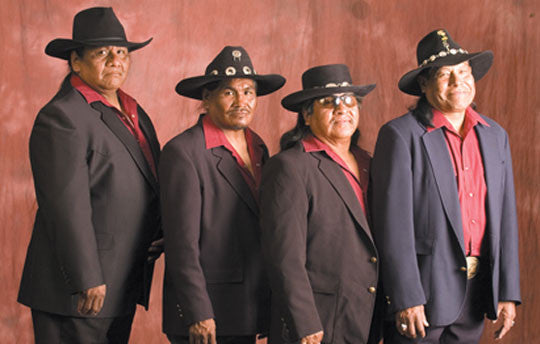Your Cart is Empty

In the early years of the twentieth century, North America's indigenous communities had little to sing about. Typically, their traditional music was banned or discouraged and they faced a depressing future. It looked as if their culture could either survive as museum fodder or be so thoroughly assimilated into the mainstream that its roots would be lost. But, there has been a dramatic turnaround, with music very much out front.

As Chris White, a member of the Oklahoma group Southern Thunder, explains: 'As we set up, we will usually burn some sweetgrass or we’ll have some tobacco – even if we just light up a cigarette and pray with that...A drum has a spirit of itself. It’s alive.'
Although the powwow is only one thread in a Native American tapestry of ceremonial dance music, it has become a symbol of Native American cultural unity and strength.
A big powwow, such as the annual Gathering of Nations held in Albuquerque, New Mexico, attracts dancers and ‘drums’ facross the United States and Canada.
Proceedings usually begin with a grand entry into the arena, led by flag bearers. Then there may be a round dance or friendship dance in which everyone – spectators and costumed dancers – side-steps around the arena in a big circle. Stomp dances, featuring a single-file of dancers and call-and-response singing may also be included. Wherever the powwow is held, the main events are the men's traditional dances in which vividly clad dancers typically imitate a stalking warrior, and the women's fancy or shawl dance and jingle dance.
While powwow serves as an inter-tribal connection, there are numerous styles and genres peculiar to certain communities.
Context is crucial to the appreciation of ceremonial music, which can sound monotonous in the extreme on a recording, but comes to life when experienced as part of a dance or religious event. The twenty or so Pueblos of New Mexico and the Hopi of Arizona hold some of the best known annual ceremonies. Most are weather or crop related, reflecting the communities’ agricultural lifestyle. One that visitors can attend in part is the Zuni’s Shalako, a creation myth reenactment held in winter. Navajo rituals, in contrast, are renowned for their focus on curing individuals.
The pioneer Native American songwriter was Buffy Sainte-Marie, whose song, “Now that the Buffalo’s Gone” remains a powerful expression of Native angst, and set a pattern of lyrical concern. Another leading outfit from the 1960s and early 1970s was the group XIT, from New Mexico, whose albums Plight of the Redman and Silent Warrior put a spotlight on Natives’ struggles for fair treatment. Native American culture has always relied heavily on the memory of its people for its historical and cultural records. Songs vividly reflect values and experiences and the importance of women and families in Native communities is a recurring theme. Not surprisingly, rap and hip-hop have had an impact on urban Natives eager to voice cultural grievances. Many groups use a backdrop of Indian drums and chanting.
A significant factor in the renaissance of Native American music is the blending of old and new musical styles. The leading figure in Native American fusion is Robbie Robertson, a part Mohawk, born in Canada.
Robertson said, “it struck me that this musicality from the Native community of North America has always lived in this very secretive, private, oppressed, sometimes illegal place... Native music has lived underground for so long, and now it is time to step forward. It’s time to do what we can just to share this with people.” Robert Mirabal, from Taos, New Mexico, forged a similar musical path with his 1997 album Mirabal, in which flutes, rattles, drums and vocables mesh seamlessly with electric instruments in what Mirabal calls ‘Alter-Native’ music.
There is a degree of hostility within indigenous communities to those regarded as New Age usurpers, and non-Natives have had to tread carefully. Many Native Americans, meantime, are experimenting with modern genres more boldly than ever before.